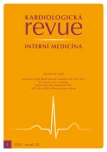Dapagliflozin and the DECLARE study – input characteristic
Authors:
J. Špinar
Authors‘ workplace:
Interní kardiologická klinika LF MU a FN Brno
Published in:
Kardiol Rev Int Med 2018, 20(1): 61-65
Overview
Gliflozins – SGLT2 – mean a new approach to the treatment of type 2 diabetes mellitus. The mechanism of action is the excretion of excess sugar via the kidneys. In 2015, the first mortality study with SGLT2 empagliflozin – EMPA-REG OUTCOME was completed, in 2017 the CANVAS programme with canagliflozin were published and further studies are ongoing. An extensive programme has been launched with dapagliflozin, where meta-analyses of smaller studies have shown very positive results in reducing cardiovascular events. A large international clinical trial with dapagliflozin has been going on under the name DECLARE, scheduled to be completed in the summer of 2018. At the beginning of 2018, the initial characteristics of the patients enrolled in this study were published. The study included 17,160 patients with type 2 diabetes mellitus who were randomized to placebo or dapagliflozin at 10 mg/day. The mean age of the patients was 63.8 ± 6.8 years, mean duration of diabetes 11.8 ± 7.8 years, mean glycated haemoglobin 8.3% ± 1.2%. A total of 6,971 (40.6%) patients had confirmed cardiovascular disease and 10,189 (59.4%) had multiple risk factors.
Key words:
gliflozines – dapagliflozin – DECLARE – input characteristic
Sources
1. Prázný M, Šoupal J. Postavení nových antidiabetik v klinické praxi: SGLT2 vs DPP4 inhibitory. Vnitř Lék 2015; 61(4): 291 – 294.
2. Zinman B, Wanner CH, Lachin JM et al. The EMPA-REG OUTCOME Investigators. Empagliflozin, cardiovascular outcomes, and mortality in type 2 diabetes. N Engl J Med 2015; 373(22): 2117 – 2128. doi: 10.1056/ NEJMoa1504720.
3. Kvapil M. EMPA REG OUTCOME. Důkaz, že populace pacientů s diabetem se mění. Remedia 2016; 26 : 67 – 72.
4. Neal B, Perkovic P, Mahaffey KW et al. Canagliflozin and cardiovascular and renal events in type 2 diabetes. NEJM 2017; 377(7): 644 – 657. doi: 10.1056/ NEJMoa1611925.
5. Raz I, Mosenzon O, Bonaca MP et al. DECLARE-TIMI 58: participants baseline charcteristics. Diabetes Obes Metab 2018. doi: 10.1111/ dom.13217.
6. Bergenstal RM, Bailey CJ, Kendall DM. Type 2 diabetes: assessing the relative risks and benefits of glucose-lowering medications. Am J Med 2010; 123(4): 374.e 9 – 18. doi: 10.1016/ j.amjmed.2009.07.017.
7. Ferrannini E, Mark M, Mayoux E. CV Protection in the EMPA-REG outcome trial: a "thrifty substrate" hypothesis. Diabetes Care 2016; 39(7): 1108 – 1114. doi: 10.2337/ dc16-0330.
8. Mudaliar S, Alloju S, Henry RR. Can a shift in fuel energetics explain the beneficial cardiorenal outcomes in the EMPA-REG OUTCOME study? A unifying hypothesis. Diabetes Care 2016; 39(7): 1115 – 1122. doi: 10.2337/ dc16-0542.
9. Vallon V, Thomson SC. Targeting renal glucose reabsorption to treat hyperglycaemia: the pleiotropic effects of SGLT2 inhibition. Diabetologia 2017; 60(2): 215 – 225. doi: 10.1007/ s00125-016-4157-3.
10. Heerspink HJ, Perkins BA, Fitchett DH et al. Sodium glucose cotransporter 2 inhibitors in the treatment of diabetes mellitus: cardiovascular and kidney effects, potential mechanisms, and clinical applications. Circulation 2016; 134(10): 752 – 772. doi: 10.1161/ CIRCULATIONAHA.116.021887.
11. Fletcher B, Gheorghe A, Moore D et al. Improving the recruitment activity of clinicians in randomised controlled trials: a systematic review. BMJ Open 2012; 2(1): e000496. doi: 10.1136/ bmjopen-2011-000496.
12. Piepoli MF, Hoes AW, Agewall S et al. 2016 European Guidelines on cardiovascular disease prevention in clinical practice: The Sixth Joint Task Force of the European Society of Cardiology and Other Societies on Cardiovascular Disease Prevention in Clinical Practice (constituted by representatives of 10 societies and by invited experts) Developed with the special contribution of the European Association for Cardiovascular Prevention & Rehabilitation (EACPR). Eur Heart J 2016; 37(29): 2315 – 2381. doi: 10.1093/ eurheartj/ ehw106.
13. Wu JH, Foote C, Blomster J et al. Effects of sodium-glucose cotransporter-2 inhibitors on cardiovascular events, death, and major safety outcomes in adults with type 2 diabetes: a systematic review and meta-analysis. Lancet Diabetes Endocrinol 2016; 4(5): 411 – 419. doi: 10.1016/ S2213-8587(16)00052-8.
14. Wanner C, Inzucchi SE, Lachin JM et al. Empagliflozin and progression of kidney disease in type 2 diabetes. N Engl J Med 2016; 375(4): 323 – 334. doi: 10.1056/ NEJMoa1515920.
15. Raz I et al. Poster 1245-P. 77th Scientific Sessions of the American Diabetes Association. San Diego, CA, 2017.
16. Raz I et al. Poster 1129. 53rd Annual Meeting of the European Association for the Study of Diabetes. Lisabon, Portugal, 2017.
17. Study NCT01730534. ClinicalTrials.gov website. Accessed December 2017.
18. In House Data, AstraZeneca Pharmaceuticals LP. CSP D1693C00001; H1 2017 results. Published 2017.
Labels
Paediatric cardiology Internal medicine Cardiac surgery CardiologyArticle was published in
Cardiology Review

2018 Issue 1
Most read in this issue
- Overview of echocardiographic parameters in the diagnostics of heart failure with preserved ejection fraction of the left ventricle
- Specifics of diagnostics and treatment in old age
- Heart failure in old age
- Old-age thyroid disease and cardiovascular disorders
